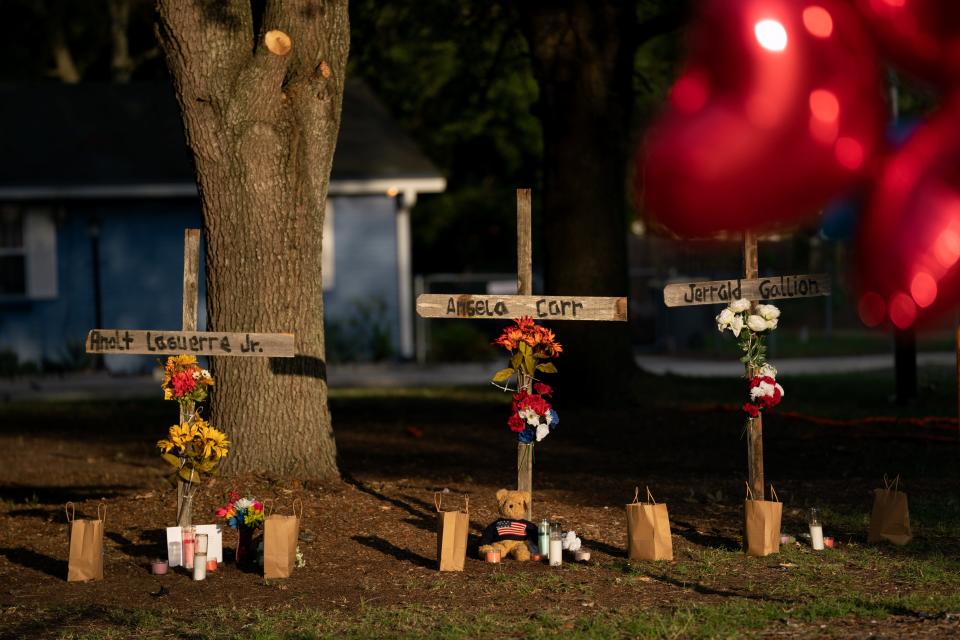Jacksonville shooting has already faded from memory. Victims deserve better from the media.
Before being replaced on the front pages of newspapers by Hurricane Idalia, the fatal shooting of three Black residents of Jacksonville, Florida, by a 21-year-old white supremacist dominated the news cycle for days – and for good reason. Although the death toll was not as high as large-scale shootings that have shocked us this year, the apparent hate motivation made it particularly newsworthy given the political climate.
The blanket coverage included surveillance video of the gunman aiming his "AR-style" rifle at defenseless victims outside and inside the Dollar General store. As is customary, viewers were warned of the disturbing nature of the images.
I watched the clips and was indeed disturbed, but not in the sense that underscored the alert. The video did not show any of the victims, much less how they were killed. What I found disturbing was the representation of the assailant as a powerful individual armed with a deadly weapon, a hero for like-minded hatemongers.
This is not an endorsement of the “no notoriety” agenda that encourages law enforcement officials and the news media to avoid showing images of the shooter or revealing his name. The identity and headshot of the assailant, as well as certain facts about the motivation and weaponry, are basic elements of the event that are absolutely appropriate for reporting.
And despite the concern for copycatting, it is the crime – not the criminal – that can inspire others to follow in the perpetrator’s bloody footsteps. Racist sympathizers might not recall the gunman’s name or face, but they certainly know – and applaud – what he did.

Unlike a simple headshot, images of the shooter in action (as in the Jacksonville rampage) or menacing poses created by the assailant (such a photo of the Virginia Tech gunman brandishing weapons that was printed above the fold on the front page of The New York Times) are gratuitous.
Unfortunately, the news media sometimes crosses the line from reporting to celebrity watch. For example, coverage of the man who killed 60 and injured hundreds more at a Las Vegas outdoor concert in 2017 included his favorite casino games, his passion for karaoke and even what he ate on the night of the shooting. Such superfluous details did not help us understand the gunman’s motivation but only humanized an undeserving individual.
Releasing 'manifestos,' 911 calls are bad practice from journalists, police alike
It has become common for killers, both the political and pathological, to post online an explanation for their planned acts of violence. They want us to know that there was a bonafide reason for murder – by their way of thinking, it is justifiable homicide. They do not wish to be remembered as just some nut who killed innocent strangers for no good reason.
An unfortunate journalistic practice reflected in the Jacksonville shooting coverage is to describe the ugly words of a hateful murderer as a "manifesto" – a term that typically refers to a political position of someone prominent. The one thing that the young man who in 2015 killed nine Black worshippers at a church in Charleston, South Carolina, got right is in insisting that his writings not be characterized in this way.
Covenant School shooting: Children are terrified of gun violence. Tennessee lawmakers should listen.
Another recent trend is for the police to release 911 calls associated with a mass shooting, sometimes containing the frantic pleas – and potentially the last words – of someone trapped in a hostage situation.
The terror in the caller's voice comes through loud and painfully clear. It is impossible not to empathize with the victim’s feelings of helplessness and horror.
Marathon coverage of mass shootings
Flying drones and camera phones have also provided dramatic sights and sounds for cable news channels to fill hours of marathon coverage of dreadful shootings.
Video recordings of frantic shoppers in El Paso, Texas, fleeing the Walmart where a gunman killed 23 had little value but considerable downsides. Not only do these recordings replayed over and over again intensify the audience’s fear by virtually placing them at the scene, they also play into fantasies of dispirited individuals who would love to recreate such chaos where they live.
Opinion alerts: Get columns from your favorite columnists + expert analysis on top issues, delivered straight to your device through the USA TODAY app. Don't have the app? Download it for free from your app store.
Far better are scenes of a community showing unity and resilience, such as El Paso residents lining up to give blood after the massacre.
Technology has enhanced the way that the news media relays an ongoing story of carnage. Satellite trucks arrive at the site of a school shooting in time to beam high-def images into living room TV screens of students jumping from windows or young children being led to safety with tears still fresh in their eyes.
Do the math on school shootings: As students head back to school, should parents worry about shootings?
These frightful images may draw viewers, but they also fuel the public’s belief that America’s schools are unsafe.
These many aspects of covering active shooter events constitute too much information, media-style. It would be wise for print and broadcast journalists to practice the words of police Sgt. Joe Friday from "Dragnet": "All we want are the facts, ma'am."

James Alan Fox is the Lipman Professor of Criminology, Law and Public Policy at Northeastern University, a member of the USA TODAY Board of Contributors, and author of "Extreme killing: Understanding Serial and Mass Murder."
You can read diverse opinions from our Board of Contributors and other writers on the Opinion front page, on Twitter @usatodayopinion and in our daily Opinion newsletter. To respond to a column, submit a comment to letters@usatoday.com.
This article originally appeared on USA TODAY: Jacksonville shooting news coverage points to disturbing media trend

